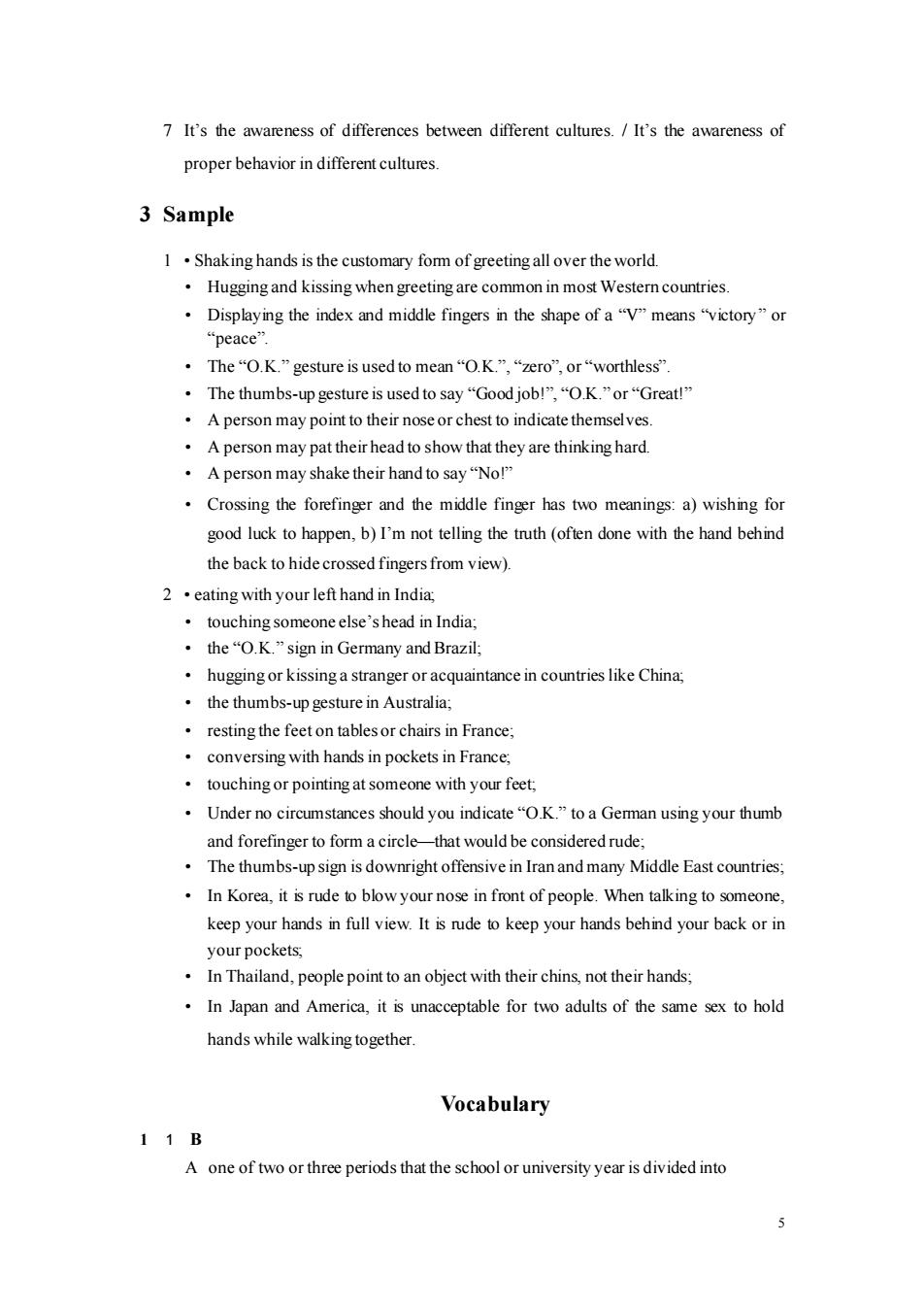正在加载图片...

7 It's the awareness of differences between different cultures.It's the awareness of proper behavior in different cultures. 3 Sample 1.Shaking hands is the customary fomm of greeting all over the world. Hugging and kissing when greeting are common in most Western countries. ·Displaying the index and middle fingers in the shape of a“V"means“victory”or “peace”. ·The“O.K.”gesture is used to mean“O.K”,“zero”,or“worthless”. ·The thumbs-up gesture is used to say“Good job!”,“O.K.”or“Great!' A person may point to their nose or chest to indicate themselves. A person may pat their head to show that they are thinking hard. ·A person may shake their hand to say“Nol Crossing the forefinger and the middle finger has two meanings:a)wishing for good luck to happen,b)I'm not telling the truth(often done with the hand behind the back to hide crossed fingers from view). 2 eating with your left hand in India, touching someone else's head in India; ·the“O.K.”sign in Germany and Brazil; hugging or kissing a stranger or acquaintance in countries like China; the thumbs-up gesture in Australia; resting the feet on tables or chairs in France: conversing with hands in pockets in France; touching or pointing at someone with your feet; Under no circumstances should you indicate"O.K."to a German using your thumb and forefinger to form a circle-that would be considered rude: The thumbs-up sign is downright offensive in Iran and many Middle East countries; In Korea,it is rude to blow your nose in front of people.When talking to someone, keep your hands in full view.It is rude to keep your hands behind your back or in your pockets; In Thailand,people point to an object with their chins,not their hands; In Japan and America,it is unacceptable for two adults of the same sex to hold hands while walking together. Vocabulary 11B A one of two or three periods that the school or university year is divided into 55 7 It’s the awareness of differences between different cultures. / It’s the awareness of proper behavior in different cultures. 3 Sample 1 • Shaking hands is the customary form of greeting all over the world. • Hugging and kissing when greeting are common in most Western countries. • Displaying the index and middle fingers in the shape of a “V” means “victory” or “peace”. • The “O.K.” gesture is used to mean “O.K.”, “zero”, or “worthless”. • The thumbs-up gesture is used to say “Good job!”, “O.K.” or “Great!” • A person may point to their nose or chest to indicate themselves. • A person may pat their head to show that they are thinking hard. • A person may shake their hand to say “No!” • Crossing the forefinger and the middle finger has two meanings: a) wishing for good luck to happen, b) I’m not telling the truth (often done with the hand behind the back to hide crossed fingers from view). 2 • eating with your left hand in India; • touching someone else’s head in India; • the “O.K.” sign in Germany and Brazil; • hugging or kissing a stranger or acquaintance in countries like China; • the thumbs-up gesture in Australia; • resting the feet on tables or chairs in France; • conversing with hands in pockets in France; • touching or pointing at someone with your feet; • Under no circumstances should you indicate “O.K.” to a German using your thumb and forefinger to form a circle—that would be considered rude; • The thumbs-up sign is downright offensive in Iran and many Middle East countries; • In Korea, it is rude to blow your nose in front of people. When talking to someone, keep your hands in full view. It is rude to keep your hands behind your back or in your pockets; • In Thailand, people point to an object with their chins, not their hands; • In Japan and America, it is unacceptable for two adults of the same sex to hold hands while walking together. Vocabulary 1 1 B A one of two or three periods that the school or university year is divided into